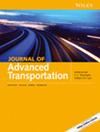Intersection Complexity Quantification Considering Driver Behavior Characteristics and Subjective Cognition
Abstract
Intersections with high complexity often present an increased risk of accidents, thereby reducing traffic safety. Current models for measuring intersection complexity primarily focus on objective factors that influence intersection operation. However, they fail to consider the impact of intersection complexity on driver behavior or the feedback mechanism drivers exhibit in response to complex traffic environments at intersections. This study aims to investigate the intrinsic connection between driver behavior and intersection complexity. A real-vehicle experiment was conducted using three two-phase signal-controlled level intersections, each varying in objective complexity. Data on seven indices related to driver behavior characteristics and subjective cognition were collected from 28 participants during the experiment. Two methods were employed to analyze the data: (1) a descriptive analysis of driving behavior characteristics under varying levels of intersection complexity and (2) an entropy-object topologically comprehensive evaluation method for measuring two-phase intersection complexity based on driver behavior characteristics and subjective cognition. The results indicated that (1) drivers’ subjective perceptions of the complexity of two-phase signal-controlled intersections significantly differed from the calculated objective complexity, (2) differences in the effects of varying signal transition methods on driver behavior at complex intersections were not statistically significant, and (3) a two-phase intersection complexity measurement model based on driver behavior characteristics and subjective perceptions was developed and validated. These findings contribute to understanding the intrinsic relationship between driver behavior and intersection complexity in urban settings. Future research could integrate intelligent algorithms to enhance the safety of autonomous vehicles navigating intersections.


 求助内容:
求助内容: 应助结果提醒方式:
应助结果提醒方式:


